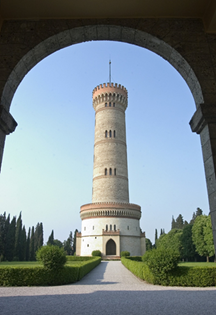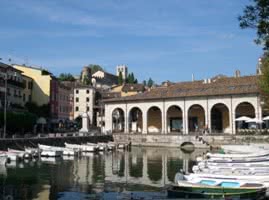Desenzano History
The architectural and cultural history of Desenzano, Italy. Churches, castles, origins and historic figures.
‘Row us out from Desenzano’ are the first words of Tennyson’s famous poem ’Ave atque Vale’, just one of the many poets who has reflected their love for the lake through the art of poetry. Whilst Tennyson, and many in our modern day use Desenzano as a mere transportation hub, this lively town is filled with a framework of historical intrigue waiting to be explored. A stilt house dates the town dwellers back to the pre-historic period. A well preserved roman villa gives an insight in to the ancient world whilst the Castle that dominates the feel of the town is an example of the changing times of history.
Under Venetian rule the town became a centre of political and economic importance in 1426. However, the historical event most associated with this town is the battle of San Martino which occurred during the second Italian war of independence. Monuments now stand where this most gruelling battle took place to mark the Italian patriotism surrounding the conflict.
San Martino Tower and the Risorgimentale Museum
The tower of San Martino stands to commemorate the king Vittorio Emmanuelle II and his forces that fought for the unification and independence of Italy. The tower exudes a feeling of Italian patriotism as you learn about the devastating battles that the Italians were subjected to in order to ensure their independence in the wars of the 19th century.
The museum behind the monument holds a number of artefacts associated with the wars and allows deeper understanding in to its history and causes. A number of artefacts and statistics from the battle of Solferino, which saw the greatest loss of life in terrible conditions, are accessible in the museum.
An ossuary in the church of San Peitro was erected in 1879 and holds the bodies of the thousands of soldiers who lost their lives in the wars for independence. You can visit the ossuary to see the skulls of the dead lined up in ranks on the wall of the church, a sobering and truly telling sight for visitors.
Climb to the top of the tower for panoramic views of the Lake to take in the setting of this richly historical area.

Todeschini Palace
This grand palace was built in 1580 by architect Giulio Todeschini. The fifteen arches which surround the palace are made of white Mascelsine stone giving the façade a pristine finish. By standing at the last portico of the palace you will be able to see a stone dated MDLV, this is known as the ‘stone of the unemployed’ as it was supposedly used as a stand for the town criers as well as a place where the bankrupt citizens stood to be whipped. The building has been used as a city hall and now houses conferences and events. Overlooking the old port it gives a stunning view of the harbour.

Castello di Desenzano
This grand and imposing castle dominates the feel of the town. The castle has a history dating back through a number of ages. Beginning, most likely, as a Roman fort and built upon in the Middle Ages. In the 15th century the castle was made to house a garrison and act as a refuge for the population of the town from invasion and in 1882 the castle was used as a barracks for the Austrian forces. This castle is well worth a visit if not for the history then for the beautiful views over Lake Garda from the terrace.
Villa Romana
One of the best preserved Roman villas in Northern Italy, Villa Romana will interest the ancient explorer, giving a valuable insight in to a typical Roman house. The villa, which was discovered by chance in 1921, dates back to AD400 and showcases a typical mosaic floor and artefacts including coins, oil lamps, frescoes and statues.
The archaeological museum
The museum showcases artefacts from the Palaeolithic to the Bronze Age which were found in the nearby peat bog of Polada and excavations in Lavagnone. This museum is home to the world’s oldest plough dating back to 2000BC made entirely from a solid piece of oak and a yoke which are both extremely well preserved. Learn about the industries of the Bronze Age such as the processing of bronze, bone and horn, agriculture and weaving.
History in Resorts Near Desenzano
More Desenzano Holiday Resources











